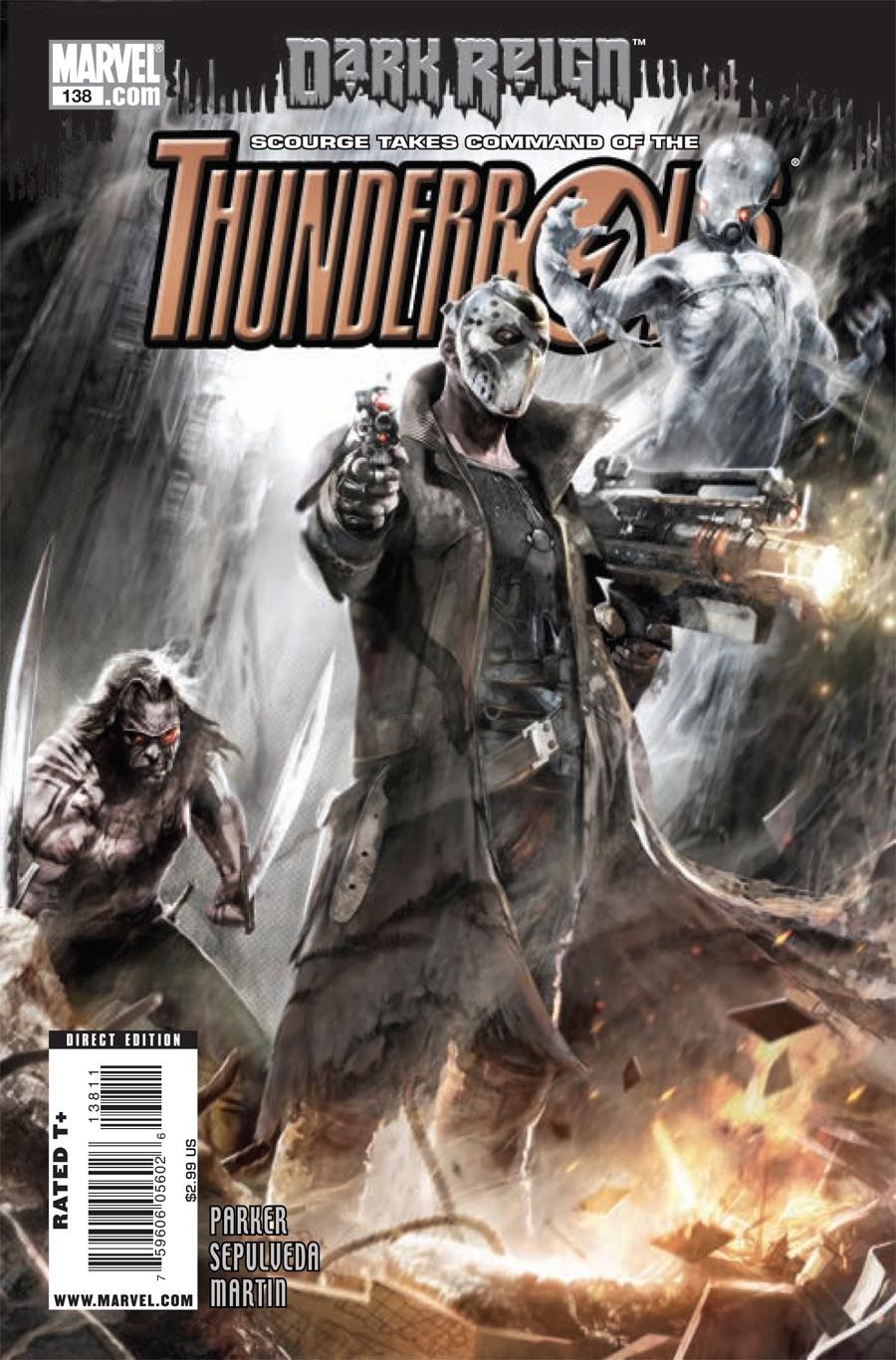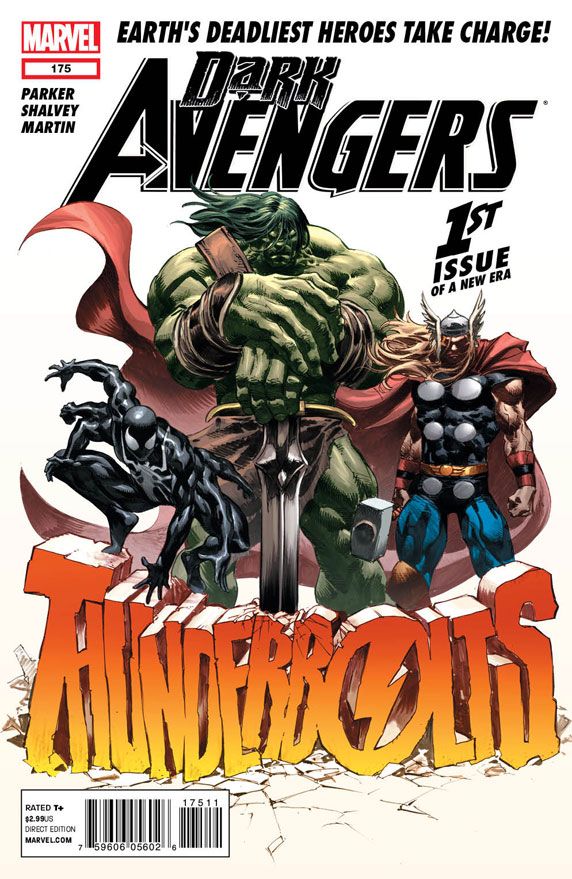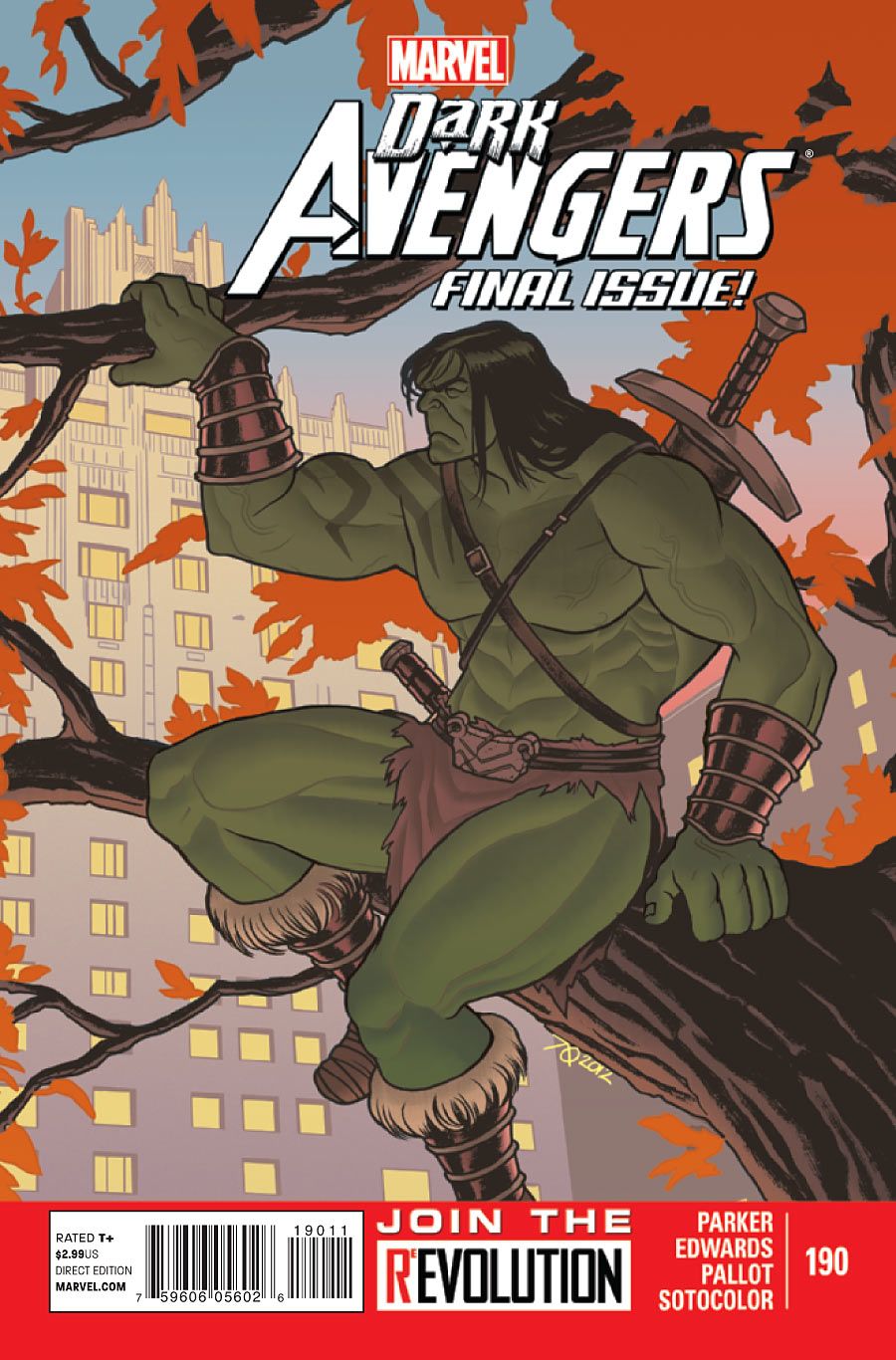Fans of Marvel Comics are well aware that the line separating super heroes and villains can be incredibly thin, but at the same time, it can also be even harder to hard to step over. Both the Thunderbolts and Dark Avengers were founded as ways for machiavellian masterminds like Baron Zemo and Norman Osborn to dupe the public into believing a team of villains were heroes, and both teams had members who were deeply impacted by the good they did in their heroic guises. Of course, those who decided to make the switch to the side of righteousness quickly discovered that the road to redemption was a long and hard hike.
Jeff Parker joined the ranks of writers to explore the concept of redemption in the Marvel Universe in 2009, first as the writer of "Thunderbolts" and then as the writer of the "Dark Avengers." Parker's almost four year on the books recently came to an end with the release of "Dark Avengers" #190, the series grand finale. We spoke with him about saying farewell to the darker corner of the Marvel U.
CBR News: Jeff, when you add up your "Thunderbolts" and "Dark Avengers" runs, you get about 50 issues. I could be wrong, but I think the only other person who has spent that amount of time with the concept of Marvel villains acting as and sometimes becoming heroes is writer Fabian Nicieza. What was it about the concept behind "Thunderbolts" and "Dark Avengers" that kept it interesting for you for so long?
Jeff Parker: Writing the characters who aren't the heroes immediately has all kinds of possibilities that you don't have with the good guys. The biggest one is that they can fail; no one is expecting that they have to win at everything they do. They can be more fallible and imperfect, and if you manage to redeem them some, it's a neat accomplishment -- but it can also be revealing if they can't be redeemed.
Also, you're able to give some real dimension to characters who aren't usually allowed the space to have that. You don't have to agree with their choices, but you can see why they make them.
You began your "Thunderbolts" run with issue #138, which hit stores in 2009, right around the tail end of Marvel's linewide "Dark Reign" storyline. What was it like taking over the book at that point?
I was essentially running out the clock until I could bring in the new status quo. That was really useful; it helped me get a sense of the dynamics of writing this kind of team. By the time the Heroic Age started and Kev Walker came on, I was warmed up and had a much clearer sense of where I wanted to go with the book.
During the Heroic Age, you molded the Thunderbolts into a more heroic incarnation led by Luke Cage. How did Luke come to be part of the book's cast? Like one of the team's previous leader's, Hawkeye, he was an Avenger with some level of leadership experience, but what else do you feel he brought to the book?
There were lots of editorial discussions about where everyone would be appearing. For a while, it was between Hawkeye and Cage for that role of the non-criminal leader, and I kept voting for Cage. I thought he made perfect sense and I wanted to show how the role would often wear him down, but then be really rewarding when it would all click. Finally, since Hawkeye was getting his own title (this was before the current Hawkguy title), they decided to let us use Cage -- and it worked beautifully. We all agreed we wanted him in more of a uniform again, so he got the yellow shirt and armbands which let him activate the nanites used to control the prisoners.
I liked showing how Cage could relate to the Thunderbolts as people, like when he meets Ghost he hands him his mask, realizing Ghost doesn't want to say anything until hidden in his chosen identity. And the way he initially gets along badly with Juggernaut, but by the oversized issue, they have an understanding.
Moonstone, a founding member of the Thunderbolts, found herself a member on your team and remained a part of the book even after it changed into "Dark Avengers." What was it about the character of Moonstone that kept her so interesting for you?
Parker eventually doubled "Thunderbolts'" cast - and sent half the characters hurtling through time
I like the meta-notion that she would connive to stay in a book even when the cast completely changed. She of course made sense since she had been a Dark Avenger before. I felt like she was more redeemed by this point than the other DA members.
Shortly after you brought Moonstone back, you reintroduced some of the team's other founders in the form of Mach V, Fixer and Songbird. What did they add to your overall run?
I think it's a book that can hold a large cast well, and they gave us perspective on how the whole history of it had been going. You get to see that Mach V is still a pretty decent guy, and so is Fixer, though he missed his criminal life and felt he sold himself out. One of my favorite issues was the Songbird focus. Even though they weren't front and center, they still shaped the book.
As you said, the book had a large cast, one that was bolstered with the introduction of the "Underbolts" team. How did that concept come about, and did you know you were going to spend a large amount of your run sending them on a time travel adventure?
That came about when we were asked to be one of the books that began double-shipping. Declan Shalvey had started working with us, and I realized I could keep an A and B team alternating so he and Kev wouldn't have to break up their story arcs, and I could tell a lot of story. At that point, though, I didn't know we were going to do time travel.
What made you split the Thunderbolts up into two groups, sending one of them hurtling through time?
I was going to have the mostly UnderBolts escape and be on the lam to switch up the dynamic, and Editor Tom Brennan suggested they actually pop out of the present time. I think he wanted one less book to coordinate with other books. I was fine with that, because I knew I'd get to tell stories like a King Arthur adventure, Jack the Ripper and all that, and it went well with the idea I had for Man-Thing becoming a thinking/talking monster. Which is something Kev Walker was immediately adamant that needed to happen: Man-Thing had to speak up. So we started sending them back to the Beginnings of Life and the artists got to really show off what they could do.
The time-lost Thunderbolts ended up being adrift in the time stream for nearly 20 issues. Did you know when you began that story that it would be that long, or did you extend it because you were having a lot of fun bouncing Fixer and his associates off of various time periods in the Marvel Universe?
Wow, I didn't realize it was that long! That's how many issues can go by when you're double shipping. I was really thinking of it as "this will happen within a year." Tom kept asking about neat scenarios, like what if the Bolts met themselves, how would that go down? And it all fell into place entertainingly. I also wanted atypical stories, like, you'd expect they'd run into dinosaurs, so we didn't go that way.
While Fixer's team was lost, the title of the series actually morphed from "Thunderbolts" to "Dark Avengers." What can you tell us about the reasons for the title change?
The Marvel NOW! T-Bolts was being put together, and we knew we had to wrap up, but we were already going to introduce the Dark Avengers as the heavies for the last story. That's when Tom got the idea to let them steal the title altogether, which worked. Orders went up, and we were approved to roll on with the book long enough to do a nice arc just with the Dark Avengers after the Thunderbolts story was resolved.
Shortly after bringing the Dark Avengers into the book, you returned the Thunderbolts to the present day for a big resolution of all your major storylines. This was also where you said goodbye to a lot of your cast members. How did it feel to wrap up that story?
It was sad and a relief at the same time. I really wanted to give them a definite conclusion, and I got to do that. I even got to bring back Juggernaut at the end, which I felt it needed. Neil Edwards came in heroically and figured out how to draw this massive cast we had grown into, without missing a step.
John Walker was a part of that story and had been a supporting player in "Thunderbolts" ever since the Heroic Age, but with your final "Dark Avengers" story, he stepped up in a major way and even reassumed his USAgent identity. What was it like writing Walker as a supporting player and then as a major player in an ensemble book?
It was fun to show Walker as human-- as much as he stoically stayed in control after losing his limbs, you see him when he has the chance to regain what he lost. It's a classic devil's deal, though he didn't realize what he was giving up. And being the original alt-Captain America, it was so perfect that he was already in place and available to jump back into the focus.
Your final "Dark Avengers" story sent the team to a corrupted AIM-created version of the Marvel Universe. Ultimately, what were your goals with this story?
My concerns were, could I move these villains along further and make them stand out a little more, when their identity so far was being dark versions of the heroes we know? It seemed useful to put them among even further twisted versions of the Marvel heroes, to see what our group was made of. I feel we made some progress, but they're not so defined that they can't be shaped more. Ragnarok I feel needed it the most, to start to emerge as his own guy.
How do you think this last arc changed your Dark Avengers? Do you think some of them are ready to be full on heroes, and are there any who you feel remain unaffected by their shared experience??
I don't think June Covington changed at all. In my mind, though, she helps show you how far Moonstone has come. The Witch meddled wildly with her teammates' lives. Obviously, USAgent wants to be a hero, but the question is, how much is June actually controlling him? Skaar will probably still be heroic -- he got the hell out of there as soon as they returned. I think Trickshot might be a slightly better guy now. Maybe.
With a title that saw so many collaborators over the years, it's only appropriate we talk about the work of the artists that brought these stories to life. You worked primarily with Kev Walker, Delcan Shalvey and Neil Edwards on this book. What do you feel they and the other artists you worked with brought to your stories?
They shaped the book, clearly. Neil being able to do all the things he does made me go big with that time-sliver story of Dark Avengers. There's literally nothing the man balks at drawing; he can design a new character and get it rolling immediately. And he's a super fellow to correspond with -- I can't wait to finally meet him in real life.
I also still need to meet Kev in the flesh! Kev set the tone that I used through the rest of "Thunderbolts" with his big style. You could take it deadly serious and hang dark humor on it. He gave me so much room to operate in, and he comes up with really funny stuff. The little toe-licking character Ferrig is one of my favorite things we created. And of course Troll, who has been the subject of excellent cosplay.
It was very cool to join up with Declan just as he was starting to really hit a new plateau and show off what he was capable of. He took things like the weird trip inside Juggernaut's soul and came back with something even weirder and cooler than I imagined. It really set the book apart in its own space. I love when he does covers; his compositions are the greatest. I think he and I should probably create a new, original project at some point.
Writing "Thunderbolts" and "Dark Avengers" really let me stretch myself as a writer and work with great pros like Bill Rosemann, Tom Brennan, Matthew Southworth, Val Deleandro and more. But I once again want to single out colorist Frank Martin, who was on the book most of the time, and even before me. He managed to synch up with every artist and give the book a look and feel nothing else had. I hope to work with him again, soon.
Finally, if there's one thing fans of your work can expect, it's variety. It seems like you love to spice things up and explore different kinds of genres in the books that you work on. So now that "Dark Avengers" is over, and "Red She-Hulk" is wrapping up, what can your fans expect from you? I understand you're having a lot of fun right now with DC's "Batman '66" book.
I'm going to try to do some things that are very kid-friendly since I haven't in a while, and some that are more mature and complex in concept. Obviously, "Batman 66" will be kid-friendly. That's already turning out to be a great time. Every artist involved is really swinging for the fence -- it's the show that made many of them cartoonists.





